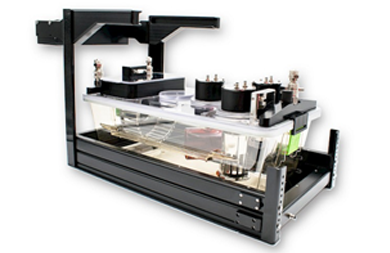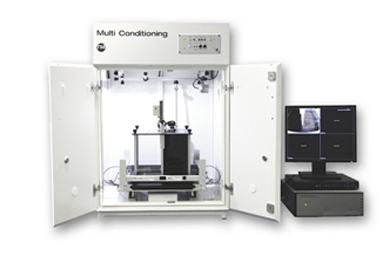The New Standard For Behavioral And Cognitive Phenotyping In The Home Cage
Intellicage
- In depth screening of individual experimental animals in a social context
- Up to 16 animals per cage, efficient testing, high throughput
- Maximal standardization and reproducibility
- Minimal human intervention, high validity
- Fully automated task performance
- Broad variety of accessible data
- Flexible design of paradigms


The IntelliCage allows you to assess the home cage behavior and cognitive performance of up to 16 individual mice or rats separately while they are living in a social environment. This unique experimental setup fosters natural social behavior in a biologically relevant, enriched but highly standardized home cage context. In this way, the IntelliCage minimizes the need for handling and human intervention, thereby increasing task validity, data reproducibility and ensuring a high level of animal welfare.
RFID transponder tagged animals are individually recognized in the fully automated conditioning corners that evaluate spontaneous behavior, operant/associative learning and memory. The four corners are equipped with sensors (continuous 24h-recording of behavioral events) and actors (allowing the system to feedback on animals’ behavior in a pre-defined way). Together with the software package using a programmable user interface, this unique sensor/actor principle grants direct behavioral shaping of group-housed animals in an all-in-one system according to diverse research interests. The visually designed paradigms run fully automated, allowing for efficient continuous testing and monitoring of large experimental animal cohorts.
Watch this Video:

Selected Publications
Voikar V, Krackow S, Lipp HP, Rau A, Colacicco G, Wolfer DP.
Automated dissection of permanent effects of hippocampal or prefrontal lesions on performance at spatial, working memory and circadian timing tasks of C57BL/6 mice in IntelliCage.
S0166-4328(17)30962-2. [Epub ahead of print] Behav Brain Res. 2017 pii:
https://www.ncbi.nlm.nih.gov/pubmed/28927717
Dere E, Ronnenberg A, Tampe B, Arinrad S, Schmidt M, Zeisberg E, Ehrenreich H.Cognitive, emotional and social phenotyping of mice in an observer-independent setting.
Neurobiol Learn Mem 2018 Feb 20. pii: S1074-7427(18)30044-3. doi: 10.1016/j.nlm.2018.02.023. [Epub ahead of print]
https://www.ncbi.nlm.nih.gov/pubmed/29474958
Masuda A, Kobayashi Y, Kogo N, Saito T, Saido TC, Itohara S.
Cognitive deficits in single App knock-in mouse models.
Neurobiol Learn Mem 2016; Nov;135:73-82. Epub 2016 Jul 1.
http://www.ncbi.nlm.nih.gov/pubmed/27377630
Phenomaster
Automated Home Cage Phenotyping
- Characterization of experimental animals under controlled conditions in the home cage
- Elimination of human bias
- Standardization of the environment
- Broad spectrum of available parameters
- High quality and reproducibility of data
- High throughput phenotyping by running large number of cages in parallel
Three disciplines combined in the home cage: metabolic, behavioral and physiological data are captured in high resolution and complete synchrony.

Selected Publications
Stubblefield JJ, Gao P, Kilaru G, Mukadam B, Terrien J, Green CB.
Temporal Control of Metabolic Amplitude by Nocturnin.
Cell Rep. 2018 Jan 30;22(5):1225-1235.
https://www.ncbi.nlm.nih.gov/pmc/articles/PMC5815321/
Bruschetta G, Jin S, Kim JD, Diano S.
Prolyl carboxypeptidase in Agouti-related Peptide neurons modulates food intake and body weight.
Mol Metab. 2018 Feb 8. pii: S2212-8778(18)30004-8
https://www.sciencedirect.com/science/article/pii/S2212877818300048
Fernández-Calleja J., Konstanti P., Swarts H., Bouwman L., Garcia-Campayo V., Billecke N., Oosting A., Smidt H., Keijer J. & van Schothorst, E. .
Non-invasive continuous real-time in vivoanalysis of microbial hydrogen production shows adaptation to fermentable carbohydrates in mice
Scientific REPORTS 2018 8:15351 | DOI:10.1038/s41598-018-33619-0
https://www.nature.com/articles/s41598-018-33619-0.pdf
Multiconditioning System
One System – Nine Paradigms
- Two configurations: large (rat & mouse), small (mice only)
- Customizable: select arena/paradigms/accessories according to your current experimental demands
- Nine pre-programmed paradigms, flexible experimental design in one chamber
- Increases intra- and inter- lab reproducibility (enclosed experimental environment)
- Experimental monitoring- live
- Preprogrammed analysis plus export file (for further statistical evaluation)
- User friendly software design

Unique Flexibility
Available pre-programmed paradigms:
- Fear conditioning
- Panic response (rat only)
- Active avoidance
- Passive avoidance
- Learned helplessness
- Conditioned place preference
- Latent inhibition
- Light-dark test
- Open field test (locomotor activity).
Selected Publications
Behavioural endophenotypes in mice lacking the auxiliary GABAB receptor subunit KCTD16. Behav Brain Res. 2017; 317:393-400
Cathomas F, Sigrist H, Schmid L, Seifritz E, Gassmann M, Bettler B, Pryce CR.
https://www.ncbi.nlm.nih.gov/pubmed/27717812
Activity-induced histone modifications govern Neurexin-1 mRNA splicing and memory preservation. Nature Neuroscience 2017; 20(5): 690-9
Ding X, Liu S, Tian M, Zhang W, Zhu T, Li D, Wu J, Deng HT, Jia Y, Xie W, Xie H, Guan JS.
https://www.ncbi.nlm.nih.gov/pubmed/28346453
VideoMot2
Video Tracking
- Flexible tool for versatile phenotyping applications
- Real 3-point detection for head and tail base tracking
- True 3-dimensional detection of rearing with combined light-beam frames
- Parallel storage of digital video files (for revision/re-analysis), access to raw data
- Ready-to-use dedicated analysis protocols (save valuable time)
- Camera connection via USB video-converter (no frame grabber required)
- Incl. 2 analysis licenses and 2 years free software upgrades

With the VideoMot system animals in nearly every arena can be tracked. Animals are detected in 3 points (head/center/tail base tracking) by a contrast filter (up to 2 animals per arena), or – in the color tracking system – by tracking color tags on the animals’ back (up to 8 animals per arena). Several arenas can be observed with one camera at a time. An unlimited number of zones of interest can be generated per arena to perform spatial analyses. Zones of interest can also be used to control data acquisition.
The output file includes information on the speed of the animal, time spent in each predefined zone of your maze, distance travelled and many more. VideoMot is routinely used for Open Field, Morris Water Maze, Radial Maze, T- and Y-Maze, Elevated Plus Maze, Light-Dark test, Object Recognition and Social Interaction tests but any test arena you can separate into zones is possible. Each experiment creates a video file for future/further analysis.

